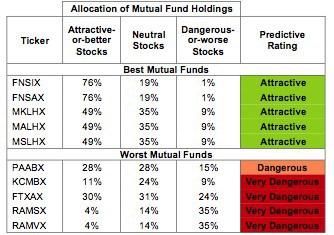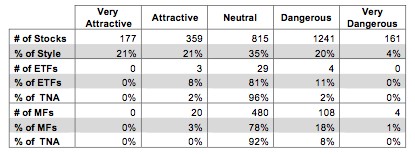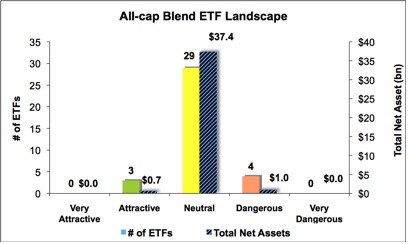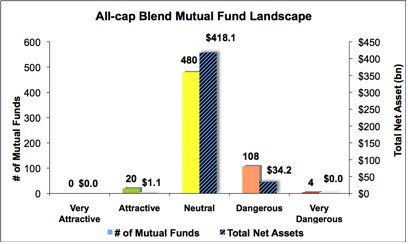The all-cap blend style ranks third out of the twelve fund styles as detailed in my Style Rankings for ETFs and Mutual Funds report. It gets my Neutral rating, which is based on aggregation of ratings of 36 ETFs and 612 mutual funds in the all-cap blend style as of February 6th, 2013. Prior reports on the best & worst ETFs and mutual funds in every sector and style are here.
Figures 1 and 2 show the five best and worst-rated ETFs and mutual funds in the style. Not all all-cap blend style ETFs and mutual funds are created the same. The number of holdings varies widely (from 16 to 3298), which creates drastically different investment implications and ratings. The best ETFs and mutual funds allocate more value to Attractive-or-better-rated stocks than the worst, which allocate too much value to Neutral-or-worse-rated stocks.
To identify the best and avoid the worst ETFs and mutual funds within the all-cap blend style, investors need a predictive rating based on (1) stocks ratings of the holdings and (2) the all-in expenses of each ETF and mutual fund. Investors need not rely on backward-looking ratings. My fund rating methodology is detailed here.
Investors seeking exposure to the all-cap blend style should buy one of the Attractive-or-better rated ETFs or mutual funds from Figures 1 and 2.
Get my ratings on all ETFs and mutual funds in this style on my free mutual fund and ETF screener.
Figure 1: ETFs with the Best & Worst Ratings – Top 5
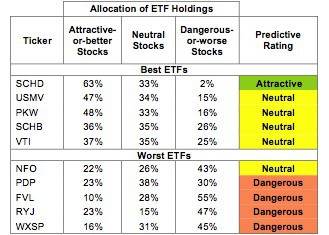 * Best ETFs exclude ETFs with TNAs less than $100 million for inadequate liquidity.
* Best ETFs exclude ETFs with TNAs less than $100 million for inadequate liquidity.
Sources: New Constructs, LLC and company filings
Six ETFs are excluded from Figure 1 because their total net assets (TNA) are below $100 million and do not meet our liquidity standards.
Figure 2: Mutual Funds with the Best & Worst Ratings – Top 5
Sources: New Constructs, LLC and company filings
Seven mutual funds are excluded from Figure 2 because their total net assets (TNA) are below $100 million and do not meet our liquidity standards.
Schwab US Dividend Equity ETF (SCHD) is my top-rated all-cap blend ETF and FundVantage Trust: Formula Investing US Value Select Fund (FNSIX) is my top-rated all-cap blend mutual fund. Both earn my Attractive rating.
Guggenheim Wilshire 4500 Completion ETF (WXSP) is my worst-rated all-cap blend ETF and earns my Dangerous rating. Starboard Investment Trust: Roumell Opportunistic Value Fund (RAMVX) is my worst-rated all-cap blend mutual fund and earns my Very Dangerous rating.
Figure 3 shows that 536 out of the 2753 stocks (over 42% of the market value) in all-cap blend ETFs and mutual funds get an Attractive-or-better rating. However, only three out of 36 all-cap blend ETFs (less than 2% of total net assets) and 20 out of 612 all-cap blend mutual funds (less than 1% of total net assets) get an Attractive-or-better rating.
The takeaways are: mutual fund managers allocate too much capital to low-quality stocks and all-cap blend ETFs hold poor quality stocks.
Figure 3: All-cap Blend Style Landscape For ETFs, Mutual Funds & Stocks
As detailed in “Cheap Funds Dupe Investors”, the fund industry offers many cheap funds but very few funds with high-quality stocks, or with what I call good portfolio management.
Investors need to tread carefully when considering all-cap blend ETFs and mutual funds, as 92% of ETFs and 97% of mutual funds in the all-cap blend style earn a Neutral-or-worse rating. Only three ETFs and 20 mutual funds in the all-cap blend style allocate enough value to Attractive-or-better-rated stocks to earn an Attractive rating. Investors should focus on buying a basket of the Attractive-or-better rated stocks in this style.
Bed Bath & Beyond Inc. (BBBY) is one of my favorite stocks held by all-cap blend ETFs and mutual funds and earns my Very Attractive rating. BBBY has grown after-tax cash flow (NOPAT) by 20% compounded annually for the last 14 years. A stable management team that is committed to efficiency enables BBBY’s consistent profit growth. Proof of this commitment to efficiency shows in its operating margins, which are consistently higher than its competitors. Despite these impressive margins and growth, BBBY is valued at only ~$60/share, giving it a price to economic book value ratio of 0.9. This ratio implies that the market expects BBBY’s NOPAT to permanently decline by 10%. Such a decline seems unlikely for a company with such an impressive record of profit growth.
TiVo Inc. (TIVO) is one of my least favorite stocks held by all-cap blend ETFs and mutual funds and earns my Very Dangerous rating. TIVO’s return on invested capital (ROIC) is -22%. Even without considering the cost of capital, TIVO is destroying quite a bit of value for investors. The company’s -32% free cash flow yield doesn’t bode well for its potential to create value in the future, either. TIVO has not earned economic profits in any year in my model, which begins in 1999. If it could not create shareholder value when it had more of an early-mover advantage with its product offerings, then I have a hard time believing it will be as profitable in the future as its valuation implies. At ~$12.80/share, the current valuation of the stock implies the company will grow revenues at 12% compounded annually while also raising its dismal -22% ROICto 30%. In other words, the market price already prices in a pretty huge turnaround in the profitability and growth of this business. Investors should focus on stocks with lower expectations.
Figures 4 and 5 show the rating landscape of all all-cap blend ETFs and mutual funds.
My Style Rankings for ETFs and Mutual Funds report ranks all styles and highlights those that offer the best investments.
Figure 4: Separating the Best ETFs From the Worst Funds
Figure 5: Separating the Best Mutual Funds From the Worst Funds
Review my full list of ratings and rankings along with reports on all 36 ETFs and 612 mutual funds in the all-cap blend style.
Sam McBride contributed to this report.
Disclosure: David Trainer and Sam McBride receive no compensation to write about any specific stock, sector or theme.

